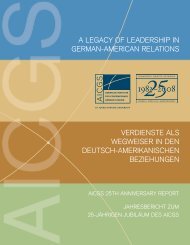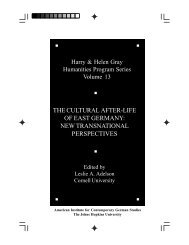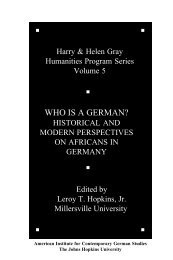the many sides of muslim integration: a german- american - aicgs
the many sides of muslim integration: a german- american - aicgs
the many sides of muslim integration: a german- american - aicgs
You also want an ePaper? Increase the reach of your titles
YUMPU automatically turns print PDFs into web optimized ePapers that Google loves.
<strong>the</strong> <strong>many</strong> <strong>sides</strong> <strong>of</strong> <strong>muslim</strong> <strong>integration</strong><br />
rapprochement.<br />
Foreign Issues, Group Consciousness,<br />
and Political Mobilization<br />
U.S. Muslims are a diverse community. While over<br />
one million persons claimed “Arab first” ancestry on<br />
<strong>the</strong> 2000 U.S. Census, various sources suggest that<br />
<strong>the</strong> number <strong>of</strong> Arab Americans and Muslims (both<br />
categories combined) is higher—close to 3 million<br />
people. O<strong>the</strong>r American Muslim organizations believe<br />
that <strong>the</strong>re are upward <strong>of</strong> 6 to 7.5 million Muslims in <strong>the</strong><br />
U.S., <strong>the</strong> community consisting <strong>of</strong> immigrants and<br />
second and third-generation Arab, Latino, Asian,<br />
European, African, and African-American Muslims. 6<br />
The three major groups—African-Americans, Arabs,<br />
and South Asians—are very different from each o<strong>the</strong>r<br />
and long-standing differences continue to divide<br />
immigrant Muslims from <strong>the</strong>ir African-American coreligionists.<br />
7 Each group is, in itself, quite heterogeneous.<br />
Among African-Americans, Islam is<br />
fragmented into several religious and political affiliations.<br />
8 Immigrant Muslims are divided along religious,<br />
linguistic, and national-origin lines. Arab Americans<br />
are extremely diverse as well in terms <strong>of</strong> socioeconomic<br />
status, length <strong>of</strong> residence in <strong>the</strong> U.S., country<br />
<strong>of</strong> origin, and religion/ religious practices.<br />
Foreign policy issues have played a significant role in<br />
<strong>the</strong> emergence <strong>of</strong> commonalities and convergences<br />
among this diverse landscape <strong>of</strong> U.S. Muslims. The<br />
process <strong>of</strong> political participation started with <strong>the</strong><br />
pioneer Arab immigrants who migrated before 1967,<br />
mainly from Syria and Lebanon, and formed interest<br />
groups and organizations such as <strong>the</strong> Arab National<br />
League and <strong>the</strong> National Association <strong>of</strong> Federations<br />
<strong>of</strong> Syrian and Lebanese American Clubs. Concerns<br />
about <strong>the</strong> fate <strong>of</strong> Palestinians increased after <strong>the</strong><br />
1967 Arab-Israeli war. The pro-Israeli attitude <strong>of</strong> <strong>the</strong><br />
U.S. government motivated <strong>the</strong> creation <strong>of</strong> <strong>the</strong><br />
Association <strong>of</strong> Arab-American University Graduates<br />
which, in addition to lobbying for Arab causes (especially<br />
Palestine), sought to mobilize <strong>the</strong> Arab<br />
American community to participate more actively in<br />
U.S. politics. At that time, <strong>the</strong> Arab American community<br />
was close to <strong>the</strong> Republican Party, especially on<br />
domestic issues. 9<br />
32<br />
In <strong>the</strong> 1980s and early 1990s, Arab Americans and<br />
new Muslim immigrants focused on U.S. foreign<br />
policy issues affecting <strong>the</strong> Islamic world such as <strong>the</strong><br />
Israeli-Palestinian conflict, U.S. sanctions against Iraq,<br />
and conflicts in Afghanistan and Chechnya. African-<br />
American Muslims, by contrast, tended to focus on<br />
domestic issues and largely supported <strong>the</strong><br />
Democratic Party. Formulating a united political platform<br />
between <strong>the</strong> two groups was not easy, as<br />
evidenced by <strong>the</strong> recurrent tensions between African-<br />
American organizations and immigrant Muslim organizations,<br />
such as <strong>the</strong> Islamic Society <strong>of</strong> North America<br />
(ISNA). Despite <strong>the</strong>se tensions, U.S. Muslims<br />
increased <strong>the</strong>ir political visibility, mainly as <strong>the</strong> result<br />
<strong>of</strong> <strong>the</strong> activism <strong>of</strong> <strong>the</strong> Muslim Public Affairs Council<br />
(MPAC) and <strong>the</strong> American Muslim Council (AMC).<br />
Although <strong>the</strong>se two organizations had good relations<br />
with <strong>the</strong> Clinton administration, U.S. Muslims<br />
resented <strong>the</strong> pro-Israeli orientation <strong>of</strong> U.S. policy in<br />
<strong>the</strong> Middle East, as well as <strong>the</strong> discriminatory effects<br />
<strong>of</strong> <strong>the</strong> 1996 Antiterrorism and Effective Death Penalty<br />
Act used mainly against Middle Easterners and<br />
Muslims. 10<br />
The 1996 presidential election represented <strong>the</strong> first<br />
major attempt at a Muslim “voting bloc” to address<br />
issues promoted by U.S. Muslims, such as immigration<br />
and civil rights, as well as foreign policy issues<br />
(mainly Palestine, Lebanon, Syria). The drive faltered<br />
however, partly as <strong>the</strong> result <strong>of</strong> a debate within <strong>the</strong><br />
community over whe<strong>the</strong>r Muslims should even participate<br />
in <strong>the</strong> American democratic process. Major<br />
Islamist organizations tried to endorse a single candidate,<br />
but actually <strong>the</strong> AMC and MPAC backed Bill<br />
Clinton, while <strong>the</strong> National Council on Islamic Affairs<br />
(NCIA) endorsed Bob Dole, and <strong>the</strong> American Muslim<br />
Alliance (AMA) and <strong>the</strong> Council on American-Islamic<br />
Relations (CAIR) took no position. 11 In late 1997,<br />
<strong>the</strong> AMA, AMC, CAIR, MPAC, American Muslim<br />
Caucus, and NCIA formed what would become <strong>the</strong><br />
American Muslim Political Coordination Committee<br />
(AMPCC) with <strong>the</strong> expressed intention <strong>of</strong> forging a<br />
single political forum. 12<br />
The 2000 presidential election saw U.S. Muslims’<br />
voting patterns take on more importance. The<br />
AMPCC endorsed George W. Bush for president<br />
without acknowledging African-American Muslim<br />
objections to that endorsement. The head <strong>of</strong> <strong>the</strong>





